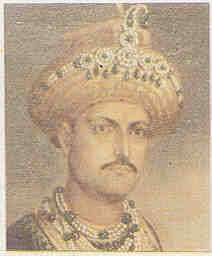Wazir Ali Khan
| Wazir Ali Khan | |||||
|---|---|---|---|---|---|
|
Mirza (Royal title) Nawab Wazir of Oudh, Nawab Wazir Marhoom va Muqfoor[nt 1] | |||||
 | |||||
| Reign | 21 September 1797– 21 January 1798 | ||||
| Coronation | 21 September 1797, Lucknow | ||||
| Predecessor | Asaf-ud-Daula | ||||
| Successor | Sa`adat `Ali Khan II | ||||
| Born |
19 April 1780 Lucknow | ||||
| Died |
15 May 1817 Vellore Fort, Vellore | ||||
| Burial |
Kasi Baghan Casia Baguan | ||||
| |||||
| House | Nishapuri | ||||
| Dynasty | Oudh | ||||
| Religion | Sunni Islam | ||||
Wazir Ali Khan (Hindi: वज़ीर अली खान, Urdu: وزیر علی خان)(b. 19 April 1780 – d. 15 May 1817) was the fourth[1] nawab wazir of Oudh from 21 September 1797 to 21 January 1798,[2] and the adopted son of Asaf-Ud-Dowlah.[3]
Life

He was adopted the son of Asaf-Ud-Dowlah, who had no son. He adopted a boy who was son of daughter of a servant. At 13 years of age Ali, was married at the cost of £300000 in Lucknow.
After the death of his adopted father in September 1797 he ascended to the throne (musnud), with the support of the British. Within four months they accused him of being unfaithful. Sir John Shore (1751–1834) then moved in with 12 battalions and replaced him with his uncle Saadat Ali Khan II.
Ali was granted a pension of 3,00,000 Rupees and removed to Benares. The government in Calcutta decided that he should be removed further from his former realm. George Frederick Cherry, a British resident, relayed this order to him on 14 January 1799 during a breakfast invitation at which Ali had appeared with an armed guard. During the ensuing argument Ali struck Cherry a blow with his sabre, whereupon the guards killed the resident and two more Europeans. They then set out to attack the house of Samuel Davis, the Magistrate of Benares, who defended himself on the staircase of his house with a pike until rescued by British troops.[4] The affair became known as the Massacre of Benares.
Subsequently Ali assembled a rebellious army of several thousand men. A quickly assembled force commanded by General Erskine moved into Benares and "restored order" by 21 January. Ali fled to Butwal, Rajputana and was granted asylum by the Raja of Jaipur. On request of Arthur Wellesley, Earl of Mornington, the raja turned Ali over to the British on the condition that he neither be hanged nor be put in fetters. Ali surrendered to the British authorities in December 1799, and was placed in rigorous confinement at Fort William, Calcutta.
The colonial government complied with this: Ali spent the rest of life – 17 years – in an iron cage in Vellore Fort in the Madras Presidency. He was buried in the Muslim graveyard of Kasi Baghan.
Children
- Mirza Jalaluddin Haidar Ali Jhan Bahadur born 1798, married and got Issue
- Nawab Mubarak ud-Daula, who moved to Ottoman Empire
- Mirza Muhammad Ali Khan
- Sahibzadi Saadatunnisa Begum
Timeline
| Preceded by Asaf ad-Dowla Amani |
Nawab Wazir al-Mamalik of Oudh 21 September 1797– 21 January 1798 |
Succeeded by Yamin ad-Dowla Nazem al-Molk Sa`adat `Ali Khan II Bahadur |
Literature
- Baillie, Laureen (Hrsg.): Indian Biographical Archiv; München, ISBN 3-598-34104-0, Fiche 492
- Davis, John Francis (1795–1890); Vizier Ali Khan; or, The massacre of Benares: a chapter in British Indian history .. (1871) (Orig. 1844)
 This article incorporates text from this source, which is in the public domain.
This article incorporates text from this source, which is in the public domain. - Higginbotham, J. J.; Men Whom India has Known. 1874
- Ray, Aniruddha; Revolt of Vizir Ali of Oudh at Benares in 1799; in: Proceedings of the Indian History Congress, 49th Session, Karnatak University, Dharwad, 1988: S 331–338
- Kartoos by Habib Tanvir
Notes
- ↑ Posthumous title
References
- ↑ Nawab Wazir Ali Khan
- ↑ Princely States of India
- ↑ HISTORY OF AWADH (Oudh) a princely State of India by Hameed Akhtar Siddiqui
- ↑ Davis, Samuel; Aris, Michael (1982). Views of Medieval Bhutan: the diary and drawings of Samuel Davis, 1783. Serindia. p. 54.
External links
- Royal line of Nawabs of Oudh
- National Informatics Centre, Lucknow – Rulers of Awadh
- NAWABS OF OUDH & THEIR SECULARISM – Dr. B. S. Saxena
- HISTORY OF AWADH (Oudh) a princely State of India by Hameed Akhtar Siddiqui